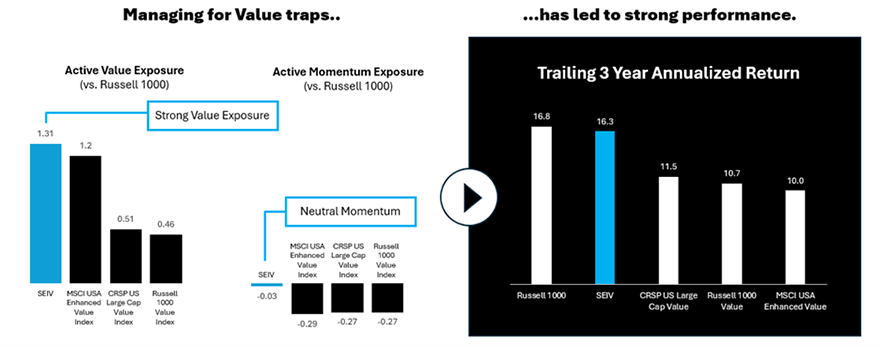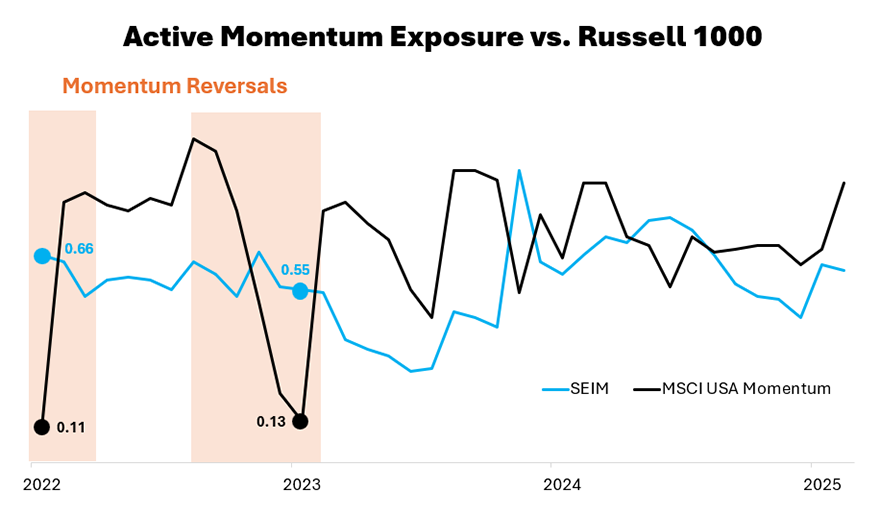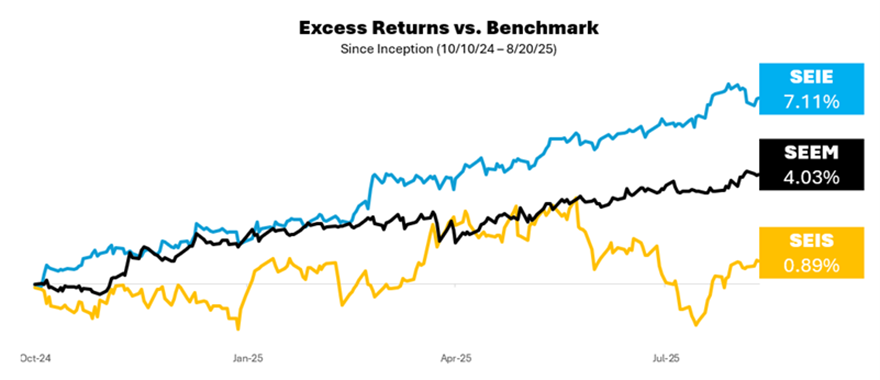Factor strategies, redefined: What drew me to SEI.
Written by: Robert Hum, CAIA
Factor strategies, redefined: What drew me to SEI
One of the driving reasons I chose to join SEI was the strength and sophistication of our Quantitative Investment Management (QIM) team.
Their approach to factor investing isn’t just smart—it’s deeply thoughtful, adaptive, and built for real-world complexity. And in a landscape where many firms lean on standardized models or broad-based indices, SEI stands out by actively managing factor exposures with precision and purpose.
As I dug deeper into SEI’s quant strategies, three specific things stood out—and ultimately reinforced for me that this was the right place to build the next chapter of my career.
1. Thoughtful construction: Designed to avoid value traps.
Value investing has long been a cornerstone of factor-based strategies, but it’s also fraught with pitfalls—especially value traps that look cheap on paper but are fundamentally broken. The SEI Enhanced US Large Cap Value Factor ETF (SEIV) features nuanced construction. Rather than relying solely on traditional metrics like price-to-book or price-to-earnings, SEIV incorporates a host of screens, such as momentum and quality, in an effort to avoid companies that are cheap for a reason.
This thoughtful layering of signals helps the strategy stay true to the value factor while helping to mitigate downside risk—a crucial distinction in today’s market where not all “cheap” stocks are created equal.
As shown below, SEIV provides exposure to the value factor, while exhibiting relatively lower exposure to negatively trending stocks. This has led to strong performance relative to peers, despite the well-known challenges we’ve seen in value over the last few years.
Source: Bloomberg as of 8/25/25.
See SEIV’s standard performance as of most recent calendar quarter-end.
The performance data quoted represents past performance. Past performance does not guarantee future results. The investment return and principal value of an investment will fluctuate so that an investor's shares, when redeemed, may be worth more or less than their original cost, and current performance may be lower or higher than the performance quoted. For performance data current to the most recent month end, please call 1‐800‐DIAL‐SEI.
2. Active factor management: Consistent momentum over time.
Factor investing is often associated with passive implementation—but SEI takes a more dynamic approach. Our QIM team actively manages factor exposures, continuously reviewing and rebalancing portfolios to reflect changing market dynamics.
Consider the SEI Enhanced US Large Cap Momentum Factor ETF (SEIM): while many momentum strategies rebalance on a fixed schedule, SEI’s approach is more frequent, more responsive, and more refined. This active oversight helps the strategy stay aligned with its intended exposure and adapt to regime shifts in real time.
As illustrated below, SEIM has exhibited relatively stable momentum exposure compared to its index-based counterparts, particularly during periods of changing market conditions (momentum reversals).
Source: Bloomberg as of 6/30/25.
3. Seeking excess returns in less efficient markets: Moving beyond U.S. Large Caps.
The team’s factor strategies have evolved well beyond traditional U.S. large-cap equities. Today, they span the globe and across market caps, applying factors like quality, value, and momentum across U.S. small caps, developed international, and emerging markets. Historically, these non-U.S. exposures have delivered strong results—demonstrating the robustness of factor investing across geographies and market cycles.
The early outcomes from this broader approach have shown more consistent performance, enhanced diversification, and stronger alignment with client objectives of seeking excess returns in less efficient markets.
Source: Bloomberg as of 8/20/25. SEIS relative to Russell 2000 Index; SEIE relative to MSCI EAFE Index; SEEM relative to MSCI EM Index.
Get each respective fund’s standard performance: SEIS, SEIE, and SEEM.
The performance data quoted represents past performance. Past performance does not guarantee future results. The investment return and principal value of an investment will fluctuate so that an investor's shares, when redeemed, may be worth more or less than their original cost, and current performance may be lower or higher than the performance quoted. For performance data current to the most recent month end, please call 1‐800‐DIAL‐SEI.
Final thoughts.
For me, joining SEI wasn’t just a career move. It was a strategic alignment with a philosophy I fervently embrace. I believe the QIM team’s commitment to rigor, adaptability, and innovation in factor investing is rare in this industry. I also believe these strategies aren’t just smart—they’re built to evolve, mitigate risk, and perform.
Glossary
Value: Seeks to invest in stocks that are inexpensive related to fundamentals
Momentum: Seeks to invest in stocks with improving earnings movement and price trends
MSCI USA Momentum Index: The MSCI USA Momentum Index is based on MSCI USA Index, its parent index, which captures large and mid cap stocks of the US market.
Important information
SEI Investments Management Corporation (SIMC) is the adviser to the SEI Funds, which are distributed by SEI Investments Distribution Co. (SIDCo.) SIMC and SIDCo are wholly owned subsidiaries of SEI Investments Company. For those SEI Funds which employ the 'manager of mangers' structure, SIMC has ultimate responsibility for the investment performance of the Fund due to its responsibility to oversee the sub‐advisers and recommend their hiring, termination, and replacement. SEI’s Quantitative Investment Management (QIM) is a team within SIMC. This information should not be relied upon by the reader as research or investment advice or recommendations (unless SIMC has otherwise separately entered into a written agreement for the provision of investment advice regarding the subject matter of this material).
To determine if the Fund is an appropriate investment for you, carefully consider the investment objectives, risk factors and charges, and expenses before investing. This and other information can be found in the Fund's full or summary prospectus, which can be obtained by calling 1‐800‐DIAL‐SEI. Read the prospectus carefully before investing.
There are risks involved with investing including loss of principal. There can be no assurance that performance will be enhanced or risk will be reduced for investment strategies that seek to provide exposure to certain quantitative factors. Exposure to such investment factors may detract from performance in certain market environments, in some cases for extended periods. In such circumstances, an investment strategy may seek to maintain exposure to the targeted investment factors and not adjust to target different factors, which could result in losses.
While the investment strategies are actively managed, the strategies’ investment process is expected to be heavily dependent on quantitative models and the models may not perform as intended.
The information contained herein is for general and educational information purposes only and is not intended to constitute legal, tax, accounting, securities, research or investment advice regarding the strategies or any security in particular, nor an opinion regarding the appropriateness of any investment. This information should not be construed as a recommendation to purchase or sell a security, derivative or futures contract. You should not act or rely on the information contained herein without obtaining specific legal, tax, accounting and investment advice from an investment professional.
This information is based on the views of, and provided by, SEI Investments Management Corporation (SIMC), a registered investment adviser and wholly owned subsidiary of SEI Investments Company. This information should not be relied upon by the reader as research or investment advice or recommendations (unless SIMC has otherwise separately entered into a written agreement for the provision of investment advice regarding the subject matter of this material).
There can be no assurance that performance will be enhanced or risk will be reduced for investment strategies that seek to provide exposure to certain quantitative factors. Exposure to such investment factors may detract from performance in certain market environments, in some cases for extended periods. In such circumstances, an investment strategy may seek to maintain exposure to the targeted investment factors and not adjust to target different factors, which could result in losses.
While the investment strategies are actively managed, the strategies’ investment process is expected to be heavily dependent on quantitative models and the models may not perform as intended.
The information contained herein is for general and educational information purposes only and is not intended to constitute legal, tax, accounting, securities, research or investment advice regarding the strategies or any security in particular, nor an opinion regarding the appropriateness of any investment. This information should not be construed as a recommendation to purchase or sell a security, derivative or futures contract. You should not act or rely on the information contained herein without obtaining specific legal, tax, accounting and investment advice from an investment professional.
250396.08






